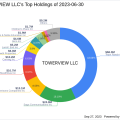- US Dollar holds its ground at the end of the week, remains in consolidation mode.
- Fed officials remain cautious on inflation, as Durable Goods Orders miss market expectations.
- Markets continue to see two cuts by year-end.
The US economy remains robust with GDPNow tracking third-quarter growth at 3.4%. The strong economic outlook might push the Federal Reserve (Fed) to adopt a more cautious stance. Investors, meanwhile, are confident of two cuts by the end of 2024.
The US economy remains robust with the Atlanta Fed’s GDPNow model tracking Q3 growth at 3.4% and the New York Fed’s Nowcast model projecting 3.0% growth for Q3 and 2.6% growth for Q4.
Daily digest market movers: US Dollar with gains, while Goods Orders fall below estimates
- Durable Goods Orders in the US declined by 0.8% MoM in September, slightly better than market expectations of a 1% decline.
- Excluding Transportation, New Orders increased by 0.4%. Excluding Defense, New Orders decreased by 1.1%.
- Transportation equipment, which has been declining for three of the last four months, contributed to the overall decrease in Durable Goods Orders.
- On the positive side, the Michigan Consumer Sentiment index rose to 70.5, beating expectations and helping the USD avoid losses.
DXY technical outlook: DXY breached 200-day SMA, now consolidating
The DXY index breached the 200-day SMA this week, but over-extension forced a retreat. The index is now expected to consolidate, correcting overbought conditions.
Despite gains by the end of the week, the Relative Strength Index (RSI) and Moving Average Convergence Divergence (MACD) indicators remain dangerously close to the overbought territory, so traders should consider eventual losses for the index. Supports lie at 104.50, 104.30 and 104.00, while resistances stand at 104.70, 104.90 and 105.00.
Central banks FAQs
Central Banks have a key mandate which is making sure that there is price stability in a country or region. Economies are constantly facing inflation or deflation when prices for certain goods and services are fluctuating. Constant rising prices for the same goods means inflation, constant lowered prices for the same goods means deflation. It is the task of the central bank to keep the demand in line by tweaking its policy rate. For the biggest central banks like the US Federal Reserve (Fed), the European Central Bank (ECB) or the Bank of England (BoE), the mandate is to keep inflation close to 2%.
A central bank has one important tool at its disposal to get inflation higher or lower, and that is by tweaking its benchmark policy rate, commonly known as interest rate. On pre-communicated moments, the central bank will issue a statement with its policy rate and provide additional reasoning on why it is either remaining or changing (cutting or hiking) it. Local banks will adjust their savings and lending rates accordingly, which in turn will make it either harder or easier for people to earn on their savings or for companies to take out loans and make investments in their businesses. When the central bank hikes interest rates substantially, this is called monetary tightening. When it is cutting its benchmark rate, it is called monetary easing.
A central bank is often politically independent. Members of the central bank policy board are passing through a series of panels and hearings before being appointed to a policy board seat. Each member in that board often has a certain conviction on how the central bank should control inflation and the subsequent monetary policy. Members that want a very loose monetary policy, with low rates and cheap lending, to boost the economy substantially while being content to see inflation slightly above 2%, are called ‘doves’. Members that rather want to see higher rates to reward savings and want to keep a lit on inflation at all time are called ‘hawks’ and will not rest until inflation is at or just below 2%.
Normally, there is a chairman or president who leads each meeting, needs to create a consensus between the hawks or doves and has his or her final say when it would come down to a vote split to avoid a 50-50 tie on whether the current policy should be adjusted. The chairman will deliver speeches which often can be followed live, where the current monetary stance and outlook is being communicated. A central bank will try to push forward its monetary policy without triggering violent swings in rates, equities, or its currency. All members of the central bank will channel their stance toward the markets in advance of a policy meeting event. A few days before a policy meeting takes place until the new policy has been communicated, members are forbidden to talk publicly. This is called the blackout period.




